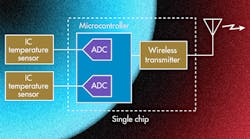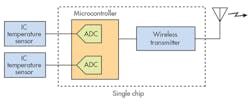Improved IC Temp Sensors Challenge Traditional Sensor Devices
Download this article in .PDF format
Probably the most electronically sensed analog quantity is temperature. An essential factor in most environments and critical in many, temperature is widely sensed in industrial, automotive, building automation, and consumer applications. Add to that the array of new applications emerging with the Internet of Things (IoT) movement. Now new semiconductor temperature sensors have arrived, which gives designers other alternatives to consider when replacing traditional sensors.
Temperature Sensor Summary
Four basic types of temperature sensors are commonly used: RTDs, thermocouples, thermistors, and IC sensors. Each seems to have a niche of applications based upon their inherent characteristics. As IC sensors have improved over the years, they are gradually replacing some of these traditional types. What follows is a summary to put things into perspective.
RTD
Resistive temperature devices (or detectors), more commonly referred to as RTDs, are widely used in industrial applications because of their wide temperature range and accuracy. An RTD is simply a resistor whose temperature varies linearly with temperature. The resistance increases in concert with rising temperature. Most RTDs use a platinum wire or thin film that has a resistance of 100 Ω at 25°C. The useful temperature range is roughly –250 to +750°C.
To get a signal from an RTD, you usually connect it into a bridge circuit and apply a dc voltage. The output voltage variation then undergoes further processing, such as amplification and linearization. One persistent problem is the introduction of an error source by any connecting cables. Many if not most RTDs are mounted remotely on tanks or pipes away from the processing circuitry. In turn, the resistance of the connecting wires introduces an error. This problem is usually solved with an extra third wire in the cable that cancels the cable resistance in the main bridge circuit.
While RTDs are highly linear, some nonlinearities must still be corrected for in applications requiring high accuracy. Some of the nonlinearity results from the inherent characteristics of the platinum itself. Nonlinearity also results from the self-heating effect of the applied voltage. Nonlinear performance can be corrected with a resistive network. Alternatively, the RTD signal can be digitized in an analog-to-digital converter (ADC); then correcting factors can be applied from a lookup table in an accompanying microcontroller.
Thermocouples
A thermocouple is created when two different metals like iron and constantan (a copper-nickel alloy) are welded together to form a junction. The junction is applied to the object that will undergo temperature measurement. This combination produces a small voltage variation with temperature on the order of tens of microvolts per degree Celsius. Amplification is required to provide a useful signal to the data-collecting or data-conversion device. If the thermocouple is used over a wide temperature range, the engineer must compensate for its nonlinearities. This is accomplished with a resistive network or after digitization using a lookup table in a microcontroller.
The main benefit of a thermocouple is its very high temperature capability. It’s the temperature sensor of choice in applications where heat levels range up to 2300°C and beyond.
Thermistors
A thermistor is a temperature-sensitive resistor made with metal oxides that has a negative temperature coefficient (NTC). With this device, increases in temperature will decrease resistance. The resistance variation is a negative exponential. The variation is on the order of –6% to +3% of the resistance value per °C. A thermistor is a much more sensitive sensor than an RTD or thermocouple. Resistance values are usually in the 1- to 100-kΩ range. Also, the typical temperature range for a thermistor is –50 to +150°C.
Thermistors are commonly used in applications that require a specific temperature trigger point or points. When a certain temperature threshold is reached, some action is initiated. In these cases, the thermistor is connected into a voltage divider whose output is compared to some fixed reference in an IC comparator. Appliances are a common application.
If the thermistor is intended for measurement over a wide temperature range, some compensation must be used to correct the nonlinearity. This can be done with a resistive network or a lookup table when the equivalent temperature voltage is digitized.
IC Sensors
In existence for many years, integrated-circuit temperature sensors have gradually improved to the point where they can replace most of the traditional sensors discussed above. In particular, they’ve overcome their initial temperature-range and accuracy limitations. Today’s best IC sensors can operate over a range of –55 to +200°C, and are accurate to within ±0.3°C. Size reductions have also made IC sensors attractive for other applications. Best of all, IC sensors dismiss the calibration procedures required with other common sensors.
Most IC sensors are based on the temperature sensitivity of a biased PN junction. The forward voltage across the junction varies linearly and inversely with temperature changes about 2 mV per degree Celsius. This can be a discrete or integrated diode, or in the case of an IC sensor, it’s a bipolar transistor connected as a diode. The base-emitter voltage (VBE) of one or more transistors is the temperature-sensitive element. By adding some support and compensating circuitry, the sensor generates an analog dc output voltage proportional to temperature variation.
The table summarizes the basic characteristics of each sensor type for comparison purposes.
Improved IC Sensors Engender New Applications
Typical of the new and improved IC sensors is Texas Instruments’ LMT70. It has a temperature range of –55 to +150°C. Accuracy is ±0.05°C, but depends on the temperature range. The 0.9- x 0.9-mm device can replace RTDs and thermistors in some applications. Its analog output voltage is usually digitized by the analog-to-digital converter (ADC) inside an accompanying microcontroller.
Such new IC sensors make it possible to replace the larger, more expensive traditional sensors that require more support circuitry and calibration. Moreover, new applications are possible.
One of these new applications is heat cost allocators. A heat cost allocator is a device that measures temperature of heat radiators in buildings to determine heat consumption so that costs can be fairly and proportionally allocated to the users. Heat cost allocators use the temperature differential between room and radiator body to assign a share of the total cost of a central heating system among multiple users. This method is used in Europe and other countries that use radiators for heating.
Heat cost allocators normally measure temperature at two points—the radiator’s surface and the surrounding air. The temperature readings can be sent wirelessly to a central collecting point for final calculations. A reference design for this application is available.
Dual IC temperature sensors, a microcontroller, and wireless transmitter combine to form a heat-cost-allocation device. ADCs in the microcontroller digitize the analog sensor data. A typical transmitter operates at 868 MHz in the license-free ISM band.
The figure shows a generic heat cost allocation design using two IC temperature sensors. ADCs inside the microcontroller convert the dc outputs from the sensors to digital values. These values are then processed by the microcontroller and the result is sent to a central collection by radio. A wireless transmitter usually operating in the < 1-GHz ISM band transfers the data. The microcontroller and wireless transmitter may be separate chips, although some manufacturers combine the two, which further simplifies the design.
Temperature probes represent another new application for these smaller IC sensors. A temperature probe is an extended cable from the sensor to the electronic thermometer to which it’s connected. The probe requires a small tip or surface area so that it can be used to measure the temperature of small parts or in restricted areas. Most IC sensors are too large for this application. Now, with a device having a package smaller than a square millimeter, probe use is possible.
Looking for parts? Go to SourceESB.



